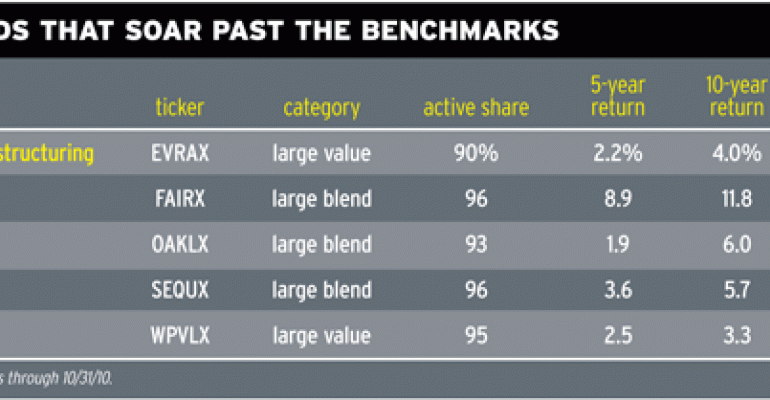Investors have been abandoning actively managed mutual funds and shifting to passive vehicles. Many investors have given up on active funds because they figure that it’s too hard to pick winners. As a result, during the first ten months of 2010, shareholders withdrew $84 billion from actively managed domestic stock funds and invested $19 billion into domestic index funds, according to Morningstar. But before you throw in the towel, consider some new research that can help to predict future stars.
The studies track a measure known as active share, which indicates how much a fund deviates from a benchmark. An index fund has an active share of 0 percent because it perfectly matches the benchmark. A fund that has no stocks in common with the benchmark would have an active share of 100 percent. Funds with high active scores tend to outperform, according to K. J. Martijn Cremers and Antti Petajisto, who are both professors at the Yale School of Management.
To check the Yale findings, Morningstar has begun tabulating data on active share. So far the professors seem to be on to something. Morningstar determined that funds with high active shares have gone on to outdo their benchmarks in the next five years.

The researchers are not sure why active funds do best, but there is little doubt about the flaws of funds with low active scores. The inactive funds should be seen as closet indexers, portfolios that hug the benchmarks closely and make no effort to outperform. The closeted funds charge high fees for active management—but employ basically the same strategy as index funds, which charge low fees.
While closet indexers never finish in the bottom of the standings, they rarely deliver winning results. “If a fund charges above-average fees and has a portfolio that resembles the index, then mathematically it is very difficult for the manager to outperform,” says Ryan Leggio, a Morningstar analyst.
The problem of closet indexing has grown worse in recent years. Examining historical records, the Yale researchers found that in 1980, there were almost no closet indexers. But by 2003, 30 percent of all equity fund assets were in closet indexers, which post active shares of less than 60 percent.
What has caused the epidemic of closet indexing? Perhaps managers have discovered that they can protect their jobs by sticking to the benchmarks and avoiding big relative losses. In the 1980s, managers may have felt free to take contrarian positions or hold stocks that were not in the benchmarks. If such bets failed, the managers faced little downside because shareholders were not savvy about performance data. When a fund lagged the S&P 500 by a percentage point or two, few investors would dump their shares and look for a better performer. But lately shareholders have become more impatient, selling funds that disappoint.
To spot winners, investors should pick funds that truly are active and deviate substantially from the index. The aim should be to find funds that consistently excel while employing a thoughtful strategy. Some the best choices have active shares of more than 90 percent and boast strong long-term records. Among funds with the highest active share is Fairholme (FAIRX). Portfolio manager Bruce Berkowitz holds a concentrated portfolio that typically includes two dozen stocks and some fixed income. He favors cash-rich companies that have fallen out of favor. Most often the approach has worked, and Fairholme has finished in the top quarter of his category in 10 of the past 11 years.
During the downturn of 2008, Berkowitz bought depressed corporate bonds and shares of unloved financials such as American Express. The moves produced huge gains when the markets revived. These days he has stakes in big banks, including Citigroup and Bank of America.
Another quirky star is Weitz Partners Value. Portfolio manager Wally Weitz buys unloved companies that can show reliable growth. When he spots bargains, Weitz is willing to focus on a few stocks. The fund often has 50 percent of assets in the top ten holdings. The strategy lags some years, but it has excelled over the long term. “Because we concentrate on a short list of companies, it is inevitable that we will be out of step with the market sometimes,” Weitz says.
For years, Weitz has favored media properties that dominate niches and generate reliable cash flows. In the past, he bought newspaper and radio companies, but these days he has more interest in cable and Internet businesses. A favorite holding is Comcast, a cable giant. Weitz says that the company has become as steady as a utility, collecting predictable fees from subscribers.
A top large blend choice is Oakmark Select (OAKLX). Portfolio manager Bill Nygren seeks solid stocks that sell for less than two thirds of their fair values. Nygren overweights bargain-priced sectors—and steers away from expensive industries. “We make no effort whatsoever to match our positions with the market weightings,” he says. “So the characteristics of the portfolio can be different from what you find in the S&P 500.”
During the Internet boom of the late 1990s, Oakmark had no technology stocks at all. Now that price-earnings multiples of technology shares have sagged, Nygren is overweight the sector. Big holdings include Dell and Texas Instruments, unloved hardware companies with solid balance sheets.






